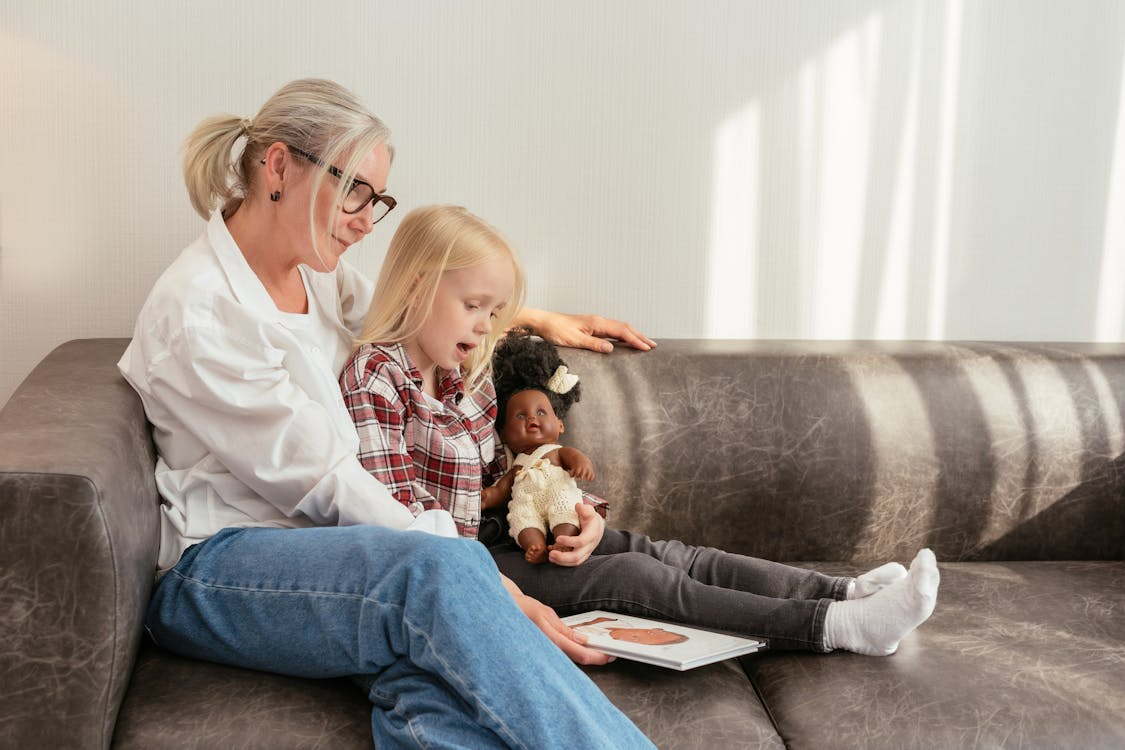
When Elizabeth Ziogas cradles her tiny doll dressed in a pink hat, something extraordinary happens. The 91-year-old’s restlessness fades away, replaced by the calm focus of a mother tending to her child. What might look like playtime is actually one of aged care’s most surprising scientific breakthroughs.
Recent studies have shown that doll therapy—once dismissed as childish—can reduce agitation in dementia patients by up to 94 per cent. Across Australian aged care homes, this evidence-based approach is helping people rediscover peace, connection, and purpose.
A grandmother’s journey back to peace
Elizabeth has been a resident of the high care unit at St Basils Lakemba in Sydney’s south-west since 2023. Diagnosed with dementia in 2020, she’s one of hundreds of thousands of Australians aged between 70 and 96 years who’ve found comfort in this unconventional therapy.
Her husband Arthur visits her every day, watching as his wife of many decades finds solace in caring for her doll. ‘We decided to introduce doll therapy to her as a way to calm her, relax her and manage her behaviours due to dementia,’ he says. ‘It really soothes her. It can calm her when she is crying or shouting as well.’
'It can calm her when she is crying or shouting as well.'
Within 30 days of starting doll therapy, research shows participants experience measurable decreases in neuropsychiatric symptoms and caregiver distress. What looks like a simple act of nurturing is backed by solid science.
The science behind the transformation
Although often referred to as ‘child representation’, the principle behind doll therapy is firmly grounded in neuroscience. Ten high-quality studies have confirmed its effectiveness, with most showing significant reductions in behavioural and psychological symptoms of dementia (BPSD).
Across multiple trials, patients exhibited lower levels of verbal and physical aggression, agitation, and wandering. Caregivers also reported less stress and emotional burden, proving the therapy benefits both residents and those who support them.
Why our brains respond to dolls
Dr Nikki-Anne Wilson, Postdoctoral Research Fellow in Cognitive Health at NueRA, explains the neurological reason behind the therapy’s success. ‘The theory behind child representation is that in a lot of forms of dementia—for example, in Alzheimer’s disease—the distant past can be far more real than what they're experiencing now.’
Remarkably, research has shown that doll therapy can also prevent delirium, providing a calming focus that captures attention and reduces risk.
This works because the caregiving instinct—deeply rooted in human nature—often persists even when other cognitive abilities fade. ‘They might even have hallucinations or delusions where they hear a baby crying and they've lost their baby, so a doll can actually provide a lot of comfort,’ Dr Wilson adds.
Research-backed benefits of doll therapy
- 94 per cent reduction in agitation symptoms
- Significant decrease in caregiver stress levels
- Helps prevent delirium in dementia patients
- Benefits both men and women equally
- Most effective with longer intervention periods
Breaking the gender myth
Despite initial hesitation from some residents, studies have shown that response to doll therapy is not determined by gender.
‘Not everyone is going to respond well to an empathy doll, but I do know it’s not a gender-based therapy—it works for both men and women,’ Dr Wilson says. ‘Men have often had children and cared for children as well. It’s more about whether it’s right for the individual.’
A Cleveland Clinic study involving 12 men and 34 women found that staff were equally encouraged by the positive responses from both genders, with more requests for dolls following early success.
How families can begin
Introducing doll therapy requires care and observation. Research shows the most successful outcomes occur when empathy dolls are introduced thoughtfully and caregivers are involved in the process.
‘You need to introduce it and watch how the person reacts,’ Dr Wilson advises. ‘If you’ve got a parent or someone who you think this might be good for, introduce the doll carefully and see how they respond to it. That’s always going to be the best way to determine whether it’s right for that person.’
At St Basil’s, Leisure and Lifestyle Manager Chrystofora Lykopantis has witnessed the benefits firsthand. ‘We have found they help to reduce anxiety and agitation among our residents and give them a sense of purpose, being able to provide care for the doll,’ she shares.
Did you know?
Longer therapy brings stronger results Research shows that longer intervention periods are more effective, with 6-month programs allowing for both an initial familiarisation phase and a later implementation phase that achieves more substantial results in reducing behavioural symptoms.
The Australian aged care revolution
Doll therapy reflects a growing shift toward person-centred care—prioritising dignity, emotional wellbeing, and connection over purely medical treatment.
Studies show it alleviates behavioural and emotional symptoms while improving quality of life for dementia patients.
Controlled trials have even demonstrated that doll therapy can serve as a first-line treatment for challenging behaviours, with measurable benefits within 30 days.
What to expect and when
While many residents show improvement within a month, longer programs often bring deeper results.
Some may initially reject the doll, but research indicates this doesn’t mean therapy won’t work—it often requires patience and gentle persistence.
Extended programs also lead to higher acceptance rates, as families and carers witness the therapy’s positive effects over time.
As Elizabeth continues to find calm in her pink-hatted companion, her story symbolises a broader change in dementia care.
What was once seen as a last resort is now recognised as a first-line, research-backed therapy—one that honours both the humanity of the person and the compassion of those who care for them.
What This Means For You
Doll therapy has shown remarkable results, reducing agitation in dementia patients by up to 94 per cent while easing the emotional strain on caregivers. It’s an approach that works across genders, offering comfort and connection to anyone open to its gentle touch.
The longer it’s used, the stronger and more lasting its benefits become—bringing calm, purpose, and dignity back into everyday life. For families watching a loved one struggle with dementia, this therapy serves as a powerful reminder that sometimes, the simplest forms of care can make the biggest difference.
If you found Elizabeth’s story moving, you’ll be inspired to learn that doll therapy isn’t the only non-medical approach changing lives for people with dementia.
Across care homes, creative therapies like art and music are also helping individuals reconnect with memories and emotions thought to be long lost.
It’s a beautiful reminder that healing doesn’t always come from medicine—but from moments of expression and connection.
How baby dolls are helping calm and relax dementia patients — Reports on the use of dolls in aged care to reduce agitation and improve wellbeing among dementia patients.
https://www.news.com.au/lifestyle/h...s/news-story/bbe71e04fbddfdcf7ab7fe3ca8647d0c
Doll therapy for improving behavior, psychology and cognition among older nursing home residents with dementia: A systematic review and meta-analysis — Systematic review showing doll therapy significantly reduces agitation, apathy, irritability, and wandering in older residents with dementia.
https://www.sciencedirect.com/science/article/pii/S0197457223002677
Baby Doll Therapy Shows Promise for Managing Agitation in Patients with Dementia — Study reporting positive effects of doll therapy for patients aged 70 to 96, including measurable improvements in behaviour and caregiver engagement.
https://consultqd.clevelandclinic.o...-managing-agitation-in-patients-with-dementia
Doll Therapy Intervention Reduces Challenging Behaviours of Women with Dementia Living in Nursing Homes: Results from a Randomized Single-Blind Controlled Trial — Research demonstrating that participants experienced significant decreases in neuropsychiatric symptoms and caregiver distress within 30 days.
https://www.mdpi.com/2077-0383/11/21/6262
Therapeutic Doll Interventions for People Living with Dementia in Care Homes: A Scoping Review — Review confirming reductions in behavioural and psychological symptoms, decreases in caregiver stress, and effectiveness across genders.
https://pmc.ncbi.nlm.nih.gov/articles/PMC11503298/
Doll therapy as a first line treatment for behavioral and psychologic symptoms of dementia in nursing homes residents: a randomized, controlled study — Study highlighting that doll therapy can help prevent delirium and provide therapeutic engagement for patients with dementia.
https://bmcgeriatr.biomedcentral.com/articles/10.1186/s12877-021-02496-0
Effect of Doll Therapy in Behavioral and Psychological Symptoms of Dementia: A Systematic Review — Findings show that longer interventions improve acceptance and lead to more substantial behavioural benefits over time.
https://www.ncbi.nlm.nih.gov/pmc/articles/PMC8950087/
Doll therapy for dementia sufferers: A systematic review — Confirms therapy alleviates behavioural and emotional symptoms while improving overall wellbeing and quality of life for dementia patients.
https://www.sciencedirect.com/science/article/abs/pii/S1744388116301888
Have you or your family experienced doll therapy or other non-medical approaches to dementia care? Share your thoughts and experiences below.







